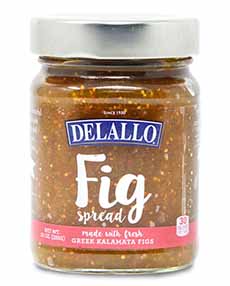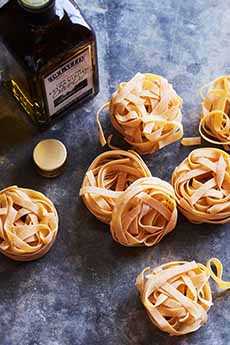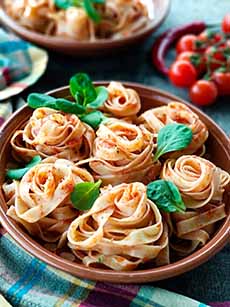RECIPE: Try A New Pasta Recipe For National Pasta Day
|
October 17th is National Pasta Day, October is National Pasta Month. Most celebrants will head for their favorites. Fettuccine Alfredo? Lasagna? Spaghetti and meatballs? We think it calls for something different and special. How about a recipe you’ve never had before? This one from DeLallo has a sauce unlike you’ve never had: both goat cheese and mascarpone, blended with fig spread, orange juice and chicken broth. It’s cheesy, fruity and savory—and topped with crumbled prosciutto. The DeLallo recipe uses a form of pasta we’ve never made: tagliatelle nests (photo #3). Because we didn’t have the time to experiment with cooking the nests (it’s supposed to be easy), we defaulted to fettuccine ribbons. “Tagliatelle is an interesting type of pasta,” says Jacqui of The Pasta Project, a great resource for any pasta lover who wants to know more about the different cuts and recipes that show them off. “[Tagliatelle] pasta ribbons have to have a particular width (normally 6-8mm wide). Make them too narrow and they could become fettuccine. Thinner still, and you may end up with bavette or tagliolini. Make them too wide and they turn into pappardelle.” She gives us a history of tagliatelle, below. Tagliatelle are typically found in nest forms. You’ve probably seen them tagliatelle nests in photos if not in person (photos #3 and #4). Why sell them in nests? For cooks who want to present the pasta in a different format, nests are ready-made bundles of individual portions. You can find nests in angel hair, fettuccine (photo #3) and other ribbons, as well. Some cooks like nests because with wider noodles, according to some sources, there is a greater problem with the flat sides sticking together and cooking unevenly. You need to spend more time over the pot with a pasta fork, separating the strands. When the wide, flat noodles are sold as a nest, they go into the pot already separated, and adherence between strands is minimal [source]. Ingredients Preparation 1. PREHEAT the oven to 400°F. Line a baking sheet with parchment paper. Arrange the prosciutto in a single layer on the baking sheet. Bake for 10 minutes or until crispy. Transfer the prosciutto to a paper towel-lined plate to cool. Once cooled, crumble and set aside. Meanwhile… 2. BRING a large pot of salted water to a boil over high heat. Cook the pasta according to package instructions and drain. 3. COMBINE the fig spread, chicken broth, orange juice, salt and pepper in a large saucepan over medium heat. Bring to a boil, reduce the heat and simmer for 5-6 minutes. Remove the pan from the heat and stir in cheeses and lemon zest until sauce thickens. 4. TOSS the hot pasta with the sauce and stir until well coated. Serve topped with the crumbled prosciutto. |
|
|
|
THE HISTORY OF TAGLIATELLE The legend is that tagliatelle was invented in 1487, when Giovanni II of Bentivoglio, Lord of Bologna, asked his chef to prepare a banquet in honor of Lucrezia Borgia. Lucrezia was stopping in Bologna on her way to Ferrara to marry Duke Alfonso D’Este. Bentivoglio wanted to honor the bride-to-be. (Don’t think of him as Mr. Nice Guy: He was a tyrant.) The chef, Mastro Zefirano, cooked a memorable banquet which included a new style of pasta. The Maestro cut wide lasagne ribbons, made with egg, into long golden strips of pasta, in honor of the bride’s legendary blonde hair. This pasta became known as tagliatelle from the Italian tagliare, to cut. Fun story, but according to Wikipedia, this was a joke invented by humorist Augusto Majani in 1931. Alas, he did not provide more of a history. Search back and you find that tagliatelle and its flat cousins originated in the Emilia-Romagna of Northern Italy, dating back to the 15th century. It has become a traditional pasta in most areas of North and Central Italy. Tagliatelle was originally always made as an egg pasta (as was the wider tagliolini). However, today, you can often find it as a durum pasta, as well. Today, many pasta companies make tagliatelle by extrusion and sell it dried in nests form, for people who want to serve individual nests (see photo # 4) [source].
|
||



